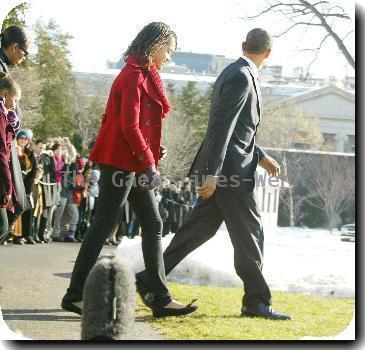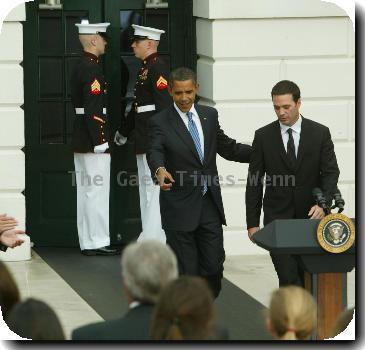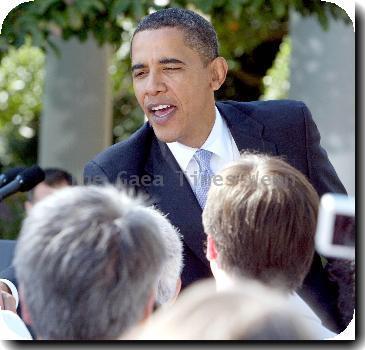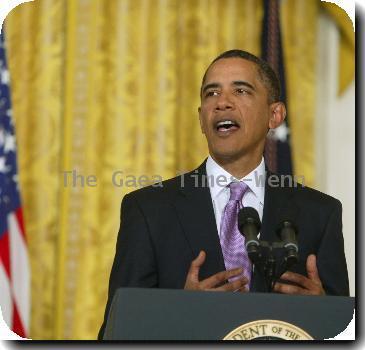SC getting millions in federal money to replace crumbling school mentioned in ‘09 Obama speech
By Meg Kinnard, APWednesday, January 27, 2010
SC gets cash to replace school cited by Obama
COLUMBIA, S.C. — On the eve of President Barack Obama’s first State of the Union, officials in a South Carolina town announced funding for a crumbling school he had cited in a speech nearly a year earlier as an example of how the federal government should help with school construction.
On Tuesday, school officials got the news they’d been waiting for — federal officials had approved funds to build a new J.V. Martin Junior High School. The U.S. Department of Agriculture said it had approved a request for nearly $40 million in recovery act funds for the Dillon County school, most of it in the form of a loan.
Some questioned the timing of the award, calling it politically motivated.
A spokesman for South Carolina Comptroller General Richard Eckstrom, whose office has been tracking the state’s stimulus funding, called it curious that the long-awaited request was approved the day before the president’s State of the Union address.
“It’s hard to imagine that there are not political considerations in a lot of these things,” R.J. Shealy said Wednesday. “Only the people in Washington know for sure. … It’s great that they’re getting the renovations they need. But it shouldn’t have taken a $787 billion stimulus to do it.”
Ray Rogers, superintendent of Dillon School District 2, home to J.V. Martin, was pleased though he said the timing was surprising. He’d been told approval would probably take a few more weeks.
The White House and USDA did not immediately respond to a request to comment on the timing of the loan announcement. But administration officials said the president would not mention the school in Wednesday night’s speech, and there were no South Carolinians on an official guest list for the address.
Politicians, including Obama, had been highlighting the dilapidated Dillon County school for more than a year by the time of Obama’s February 2009 speech. He and several other presidential candidates visited the school during the run-up to the 2008 election. And Obama first brought national media attention to the students’ plight in August 2007, when he winced as a high-pitched train whistle interrupted lessons during his visit.
All but $4 million of the federal money the county is receiving is a loan, which the area will pay back using revenue from a 1-cent sales tax levied in 2007, Rogers said. Some of the money will be used to refurbish existing facilities and build a new early childhood development center. But about $25 million will go toward building a new J.V. Martin Junior High School.
The school is in a rural swath along Interstate 95 in the state’s northeastern corner known as the Corridor of Shame, after a 2005 documentary about conditions in schools there. The school itself is a hodgepodge of buildings; the original part, a former church, dates to 1896, and the latest section was added in 1955. The auditorium, built in 1917, was condemned in 2008 by the state fire marshal.
When Obama discussed the school during his first congressional address, 14-year-old eighth-grade student Ty’Sheoma Bethea was in the audience as one of his invited guests.
National support for the crumbling school began to pour in. Students got the surprise of their lives in May, when the CEO of a Chicago company donated $250,000 worth of new furniture and fresh paint on the cafeteria’s walls. Bethea spoke about the school’s struggles. The dress she wore to the president’s speech was ensconced in South Carolina’s state museum.
With the spotlight trained on their district, officials also began dreaming of what a new facility would look like. Officials in July launched an effort to rebuild the school into a model for success with a two-day conference. Architects and engineers have been doing pro bono work for the district to design a new school.
“We’ve been dreaming a little bit about … turning it into a prototype of what a 21st century school would look like in a poor, rural community,” said State Education Superintendent Jim Rex. “What the USDA money means, we’ve got the bird in hand. The next phase is the eagle.”
Rogers, the local superintendent, says he’s ready to take the project full speed ahead.
“It’s been slow, but the problem is, we didn’t know that the economy was going to take the downturn that it has,” Rogers said Tuesday. “A lot of people have worked hard. Whatever we can do is going to be great for the kids.”
Tags: 2010 State Of The Union Address, Barack Obama, Columbia, Events, Executive Branch, North America, South Carolina, State Of The Union Address, Union, United States
|
February 6, 2010: 10:54 am
What Meg Kinnard got wrong: 1) the latest “addition” to the JVM campus is actually the main building, the two-story red brick structure housing the principal’s office, the school library, and most of the classrooms, built in 1984 to replace the main building that burned down in October 1980; 2) as with all of her predecessors covering this story for McClatchy Company, Media General, the AP, the Chicago Tribune, Salon.com. NPR, and the Washington Post–Ms. Kinnard fails to investigate how the school got to be in such poor condition, physically and academically; such an investigation would require 3) a thorough examination of the local political conditions, which would quickly show that Dillon County remains the ONLY county in SC to have NO elected school boards–all serving board members are appointed to office–which goes a long way in explaining why Dillon County had the State’s highest rate of high school dropouts (almost 40% of the adult population, per the 2000 US Census) and the highest proportion of adults who never even completed ninth-grade (almost 16% of the adult population, 2000 US Census figures. |








Edward Roberts